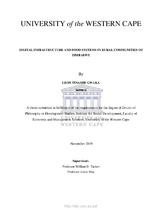| dc.description.abstract | This study examines the relationship between digital infrastructure and the sustainability of
livestock systems in Beitbridge, Zimbabwe. The study aims to answer the question: Do digital
infrastructure transformations impact the sustainability of livestock systems in rural communities?
By answering this question, the study contributes towards efforts to enhance food security in rural
communities, achieve Sustainable Development Goals (1, 2, 5 & 9) at grassroots levels as well as
achieve the Zimbabwe Agenda for Sustainable Socio-Economic Transformation. The study details
a digital infrastructure intervention in Beitbridge and applies post-positivist approaches towards
the intervention’s impact assessment to develop recommendations on whether digital
infrastructure interventions should be prioritized in rural communities towards improving food
security. The study was conducted in four villages of Ward 15 in Beitbridge and the target
population were livestock system actors. Using a mixed methods approach, data collection, with
the assistance of locally recruited research assistants, was conducted between 2015 and 2018.
Qualitative data were collected using community visioning workshops, key informant interviews,
focus group discussions and participant observations. Household survey questionnaires were used
to gather quantitative data. Data analysis was completed using a mixed methods approach. The
first objective of the study, using the Socio-Ecological System framework, was to characterise the
livestock system, explore livestock contribution towards household food security and determine
the livestock system’s sustainability. The study established that livestock play multiple roles
towards household food security contributing to different dimensions of food security. Households
sell livestock to generate income to purchase (access) food and include animal source foods in
their diets even though different consumption patterns of different livestock species were observed.
Apart from this, livestock also play sociocultural roles. However, the study established that the
livestock system is fragile, stemming from multiple factors such as poor governance and a lack of
appropriate infrastructure. Secondly, using Kleine’s Choice Framework, the study investigated the
potential of digital technologies to contribute towards sustainable livestock systems. Study
findings suggest that digital technologies can enhance the dimensions of choice of livestock system
actors. However, a lack of digital infrastructure inhibits the integration of digital technologies in
the livestock system. The potential of these technologies and the fragility of local value chains has
however triggered interventions by government and non-governmental organisations including the
MOSMAC project in Beitbridge rural. | en_US |

